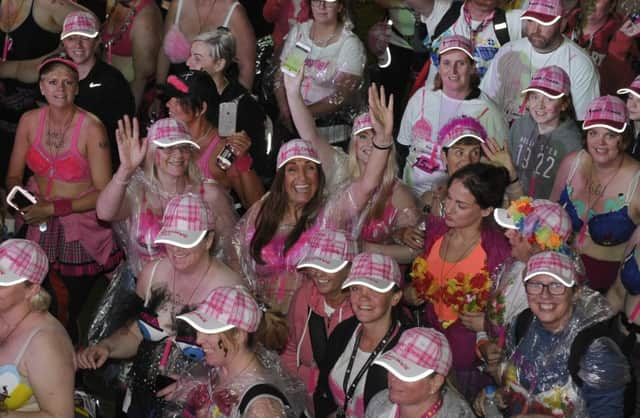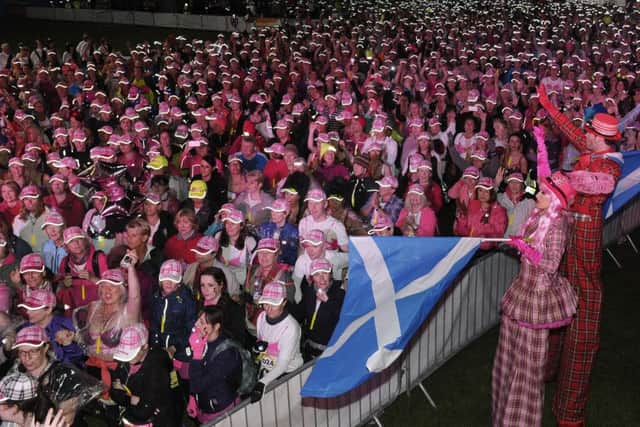MoonWalk founder on the benefits of power walking


As someone who, admittedly, rarely runs and has never power walked, that comes as a relief and with just over two months left before the charity’s 13th MoonWalk Scotland, there is no person better to learn the basics from than the event’s organiser.
She informs me that the average walker travels at around three miles per hour, but by propelling off the toes, power walkers can reach up to speeds of nearly double that.
Advertisement
Hide Ad“You progress at your own pace, whether that is 500 yards to your corner shop and that is a lot for you or going out and doing five miles straight away,” she says.


“It is about getting out and starting in a place that is good for you and I think that is what makes walking so appealing and so accessible.”
However, the annual MoonWalk event, which takes place in Scotland, England and Iceland, is not just a catalyst for a change of lifestyle and improved personal fitness; it is transforming lives by raising millions of pounds for breast cancer charities each year.
Like many great ideas, the event was inspired by a dream of Barough’s 20 years ago when she pictured a group of women power walking the New York City Marathon in brightly coloured bras to raise funds for breast cancer charities.
She could never have imagined that it would lead to raising more than £122 million and be replicated by more than 3,000 power walkers in Scotland every year.


“I just liked the idea at first and then I used to ask people if they wanted to join me on this in New York.
“However, I didn’t really do anything about it at first.
Advertisement
Hide Ad“It was probably about six weeks later when somebody asked me if I was going to be doing that walking thing and I said: ‘yeah, actually, I will’.
“It was literally as flippant as that and yet it has been a life-changing decision.”
Advertisement
Hide AdAs part of a group of 13 women, the former production company owner power walked the marathon topless but for a decorated bra.
They raised more than £25,000 for Breakthrough Breast Cancer Research, which has since become part of Breast Cancer Now.
Despite always having a keen interest in health and fitness, Barough had never raised funds for charity and she knew little about cancer.
However, her mission was timely because in the months following, her life was turned upside down when she received her own breast cancer diagnosis.
“I wouldn’t have found my own breast cancer had I not been doing the fundraising because my awareness was so heightened and I had just found this lump when I was in the shower. It was so tiny that it was like a dried pea and ordinarily I would have just thought it was part of me and of course it was anything but.”
In an effort to continue raising that awareness, Barough founded the Surrey-based charity Walk the Walk, which organises the MoonWalk and is a media partner of The Scotsman’s sister paper, Scotland on Sunday.
Advertisement
Hide AdThis year, there is a choice of distances starting at 6.55 miles right up to 52.4 miles, or a double marathon, and developing a training plan is the key to success at all levels.
“With any activity, the most important thing is that it fits in with your life,” explains Barough.
Advertisement
Hide Ad“We can write a training plan and know that is what needs to be done each week and we can really help people week by week.
“It is important to acknowledge the stepping stones along the way, you don’t just step out on day one and decide to walk a marathon.
“For some people, that first mile is a huge achievement that should not be overlooked.”
When signing up to the MoonWalk, participants receive a training booklet that contains a 12-week plan arranged by Barough, who is also the author of Walking for Fitness.
For beginners, the focus of the training should be on stamina and strength rather than speed and when starting to power walk, upholding the correct posture is fundamental.
With my back straight, Barough positions my head upright as if being held up by a string and pushes my shoulders back so that they move downwards.
Advertisement
Hide AdMy hips are pushed slightly forward and my arms are held in a 90-degree angle and with a normal stride, I am told that the feet should move in a rolling heel-to-toe action.
As a first time power walker, maintaining both the pose and the rolling foot movement was proving to be a challenge.
Advertisement
Hide AdHowever, finding out that the MoonWalk’s oldest participant was in their 90s was inspiration to master the basics and with the use of techniques such as steady breathing and repeating a mantra, it soon began to feel natural.
“For anybody walking anywhere, it is better than sitting on a settee, but if you can raise your heart rate, you then begin to really change things within your body,” Barough explains.
“It is very good for the heart and the benefits of walking are endless.”
Walking is often said to be the perfect form of exercise because it works every part of your body and uses muscles that generally do not get worked otherwise.
A series of stretches including the double leg, the single straight leg and those aimed at the upper body warms those muscles up.
The activity is also largely beneficial for mental health and wellbeing.
“Emotionally, it really helps me,” she explains.
Advertisement
Hide Ad“I’ve been through breast cancer, I’ve been through child birth, I’ve been through all sorts of things and I love walking with people and it is incredibly sociable.
“I also love the times when I am walking on my own, which is a great time for problem solving, that is very calming.
Advertisement
Hide Ad“If you are having a really bad day, taking a half hour walk can really transform everything.”
That emotional boost and social advantage of power walking is an added motivation to continue to train.
Walk the Walk’s website offers a service for participants of the MoonWalk to find a training partner in their area as well as tips, equipment advice and training plans.
One of the great things about walking is, according to Barough, that there is no time limit to the activity and it can be done in the countryside, up and down hills or in a busy town.
Wherever the location, now is the time to start training for MoonWalk Scotland, which has raised more than £20 million to date since 2006 and is continuing to grow.
“A lot of people who sign up for the MoonWalk do it from start to finish and just want to get to the end,” she adds.
“Then they start getting competitive with themselves.
Advertisement
Hide Ad“It’s not a race, it’s about signing up and it is about this wonderful circle where you do something for yourself, but you are also doing something fantastic for many people you will never meet and I think that becomes quite addictive.
“I think it’s really important that people can do this for themselves, but can also make a huge difference to those who have breast cancer.”
Advertisement
Hide AdSetting off from Holyrood Park in Edinburgh the MoonWalk Scotland is back on Saturday, 9 June and people can sign up for the event at walkthewalk.org.
Walking for Fitness by Nina Barough is published by Penguin Random House and provides tips and advice for anyone interested in learning about power walking